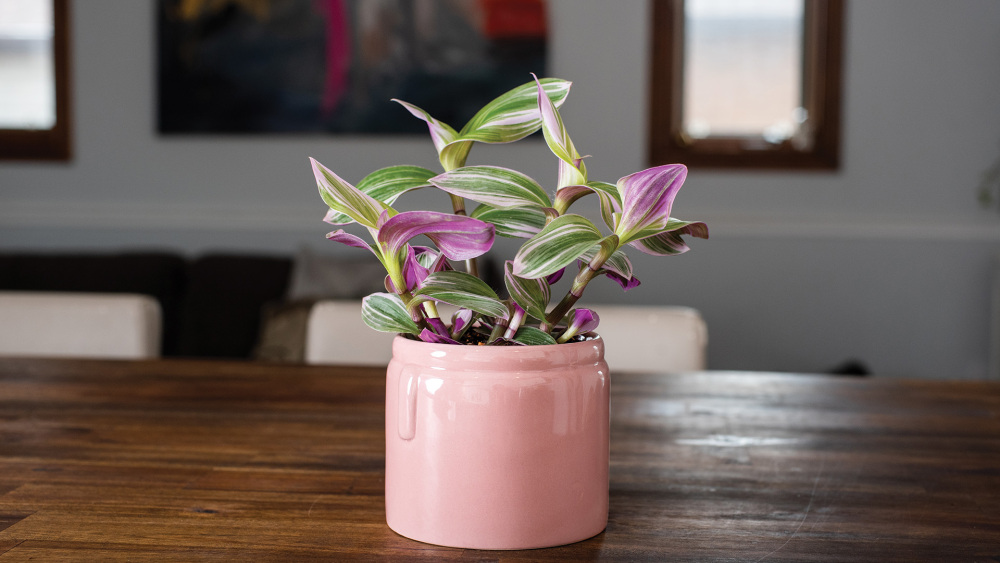
In the growing world of indoor plants, the Nanouk plant has captured the hearts of plant lovers everywhere. Its wide range of colors and easy care make it a favorite. The Nanouk is a member of the Tradescantia genus, characterized by its striking foliage with hues ranging from green to purple, pink, and white. Its vibrant, trailing stems make it a perfect candidate for hanging baskets or cascading over shelves.
If you're considering adding a Nanouk to your indoor garden or have one already, here's a comprehensive guide on how to care for this delightful houseplant.
One of the key aspects of Nanouk care is providing it with the right amount of light. It can tolerate lower light conditions however, it thrives in bright, indirect light. Avoid placing it in full direct sunlight, as this can scorch its delicate leaves and lead to brown, dried up or damaged leaves.
Similar to numerous indoor plants, the Nanouk thrives in damp soil but is prone to root rot if it's excessively watered. Let the top inch of soil dry before each watering, then thoroughly hydrate your Nanouk plant, making sure excess water is properly discarded. When watering into a pot without drainage holes, be sure to discard any excess water as this can lead to root rot. In winter, reduce watering frequency to your plants needs.
Maintain moderate to high humidity levels to mimic its natural tropical environment. You can achieve this by misting the plant regularly or placing a humidifier nearby. Nanouk plants flourish in temperatures ranging from 65°F to 75°F (18°C to 24°C) and need to be shielded from drafts.
Use a well-draining potting mix rich in organic matter to provide a healthy growing medium for your Nanouk. Fertilize your plant monthly during its growing season (spring and summer) with a balanced liquid fertilizer that is diluted to half strength, be sure to follow the directions on the bottle for application. Avoid fertilizing during the dormant winter months.
Repotting a Tradescantia Nanouk is important to ensure it has enough space for healthy root growth and vibrant foliage. Typically, the plant should be repotted every 1–2 years or when it becomes root-bound, which can cause it to outgrow its container and result in slower growth. Choose a pot that is 1–2 inches larger in diameter than the current one, with drainage holes to prevent waterlogged soil. Gently remove the Nanouk from its pot, loosening any compacted roots without damaging them. Place the plant in the new pot, filling around the roots with a well-draining potting mix, such as a general houseplant mix with added perlite or sand for improved aeration. After repotting, water the plant thoroughly to settle the soil and reduce transplant shock. Keep the plant in a bright, indirect light spot and allow the soil to dry slightly between waterings. Repotting helps maintain the plant’s health and encourages continuous growth, preserving its vibrant pink and green leaves.
Regular pruning helps maintain the Nanouk's compact, bushy growth habit and encourages new growth. Trim leggy stems to promote branching and remove any dead or yellowing leaves to keep the plant looking its best.
Nanouk plants are easily propagated through stem cuttings. Just cut a robust stem beneath a leaf node, take off the bottom leaves, and position the cutting in water or damp potting soil. Once you notice roots develop, transplant the cutting into its own pot, provide it with a high humidity environment while it establishes it root system and watch your Nanouk grow!
Tradescantia Nanouk, also known as Fantasy Venice, is generally considered toxic to pets, including cats and dogs. If ingested, it can cause symptoms such as vomiting, drooling, and diarrhea. Additionally, the plant's sap can cause skin irritation for some animals if they come into contact with it.
If you have pets at home, it's a good idea to keep Tradescantia Nanouk out of their reach to prevent any potential issues.
If the variegation on your Tradescantia Nanouk starts fading, here are some effective ways to revive it: